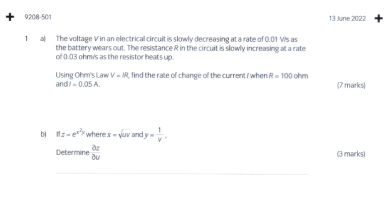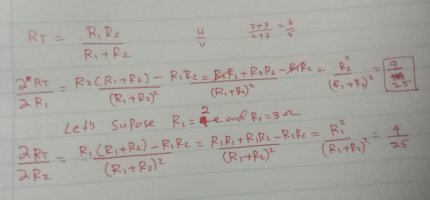I have already given you the formula for the percentage error for two resistors connected in parallel. You just need to plug the given values in it. If you want to derive this formula with calculus, I can show you.
We know that the formula for calculating the equivalent resistance connected in parallel is:
RT1=R11+R21
And we know that the percentage error in
RT is
RTdRT.
We want to find a way to get this percentage error from the given equivalent resistance formula.
Let
z=RT1
And
x=R11
And
y=R21
Then, we have:
z=x+y
From calculus, we know that the total differential
dz is:
dz=∂x∂zdx+∂y∂zdy
∂x∂z=1 And
∂y∂z=1
Then we have:
dz=dx+dy
We will find the derivatives of the formulas at the beginning above.
dRTdz=−RT21 then,
dz=−RT2dRT
dR1dx=−R121 then,
dx=−R12dR1
dR2dy=−R221 then,
dy=−R22dR2
Then, we have:
−RT2dRT=−R12dR1−R22dR2
Or
RT2dRT=R12dR1+R22dR2
Or
RTdRT=RT(R12dR1+R22dR2)=RT(R11R1dR1+R21R2dR2)
It does not matter if you will use in the formula
dRT or
ΔRT. The main point in the formula is that
dRT (or
ΔRT) is the error and
RTdRT(or RTΔRT) is the percentage error. The same thing applies to each resistor, for example,
dR1 is the error in the resistor
R1 and
R1dR1 is the percentage error in
R1.
Bonus answer: If the percentage error of
R1= the percentage error of
R2 for two resistors connected in parallel, then the percentage error of
RT must be the same.







